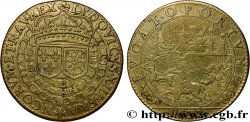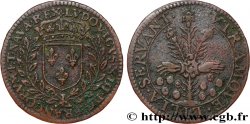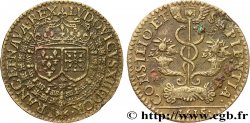v23_1135 - LUDWIG XIII DAS GERECHTE Imposition de la loi commune (l’édit de Nantes) en Béarn 1620
MONNAIES 23 (2004)
Startpreis : 280.00 €
Schätzung : 550.00 €
Erzielter Preis : 504.00 €
Anzahl der Gebote : 5
Höchstgebot : 504.00 €
Startpreis : 280.00 €
Schätzung : 550.00 €
Erzielter Preis : 504.00 €
Anzahl der Gebote : 5
Höchstgebot : 504.00 €
Type : Imposition de la loi commune (l’édit de Nantes) en Béarn
Datum: 1620
Name der Münzstätte / Stadt : Paris
Metall : Silber
Durchmesser : 27 mm
Stempelstellung : 6 h.
Gewicht : 5,33 g.
Rand lisse
Seltenheitsgrad : R1
Kommentare zum Erhaltungszustand:
Très bel exemplaire, bien centré, et recouvert d’une jolie patine grise de collection
Vorderseite
Titulatur der Vorderseite * LVDOVICVS. XIII. D. G. FRAN - CORVM. ET. NAVARÆ. REX.
Beschreibung Vorderseite Écu accolé de France et de Navarre sous une couronne, le chiffre du roi entre trois couronnes sous les écus, le tout entouré des colliers de l'ordre de Saint-Michel et du Saint-Esprit.
Übersetzung der Vorderseite (Louis XIII, par la grâce de Dieu, Roi des Francs et de Navarre).
Rückseite
Titulatur der Rückseite DISCITE. IVSTITIAM. MONITI.
Beschreibung Rückseite En face d’un groupe d’hommes regardant à gauche, un bras sortant d’un nuage et tenant une épée flamboyante, au-dessus de laquelle brille une étoile ; au second plan, une ville, avec des montagnes dans le lointain ; à l’exergue : .1620..
Übersetzung der Rückseite (Apprenez la justice de celui qui en est éclairé).
Kommentare
Les protestants du Béarn avaient refusé d’appliquer l’édit de Nantes. En 1620, le jeune roi décide, seul et contre l’avis de son Conseil, de faire respecter l’édit en Béarn. Il quitte Poitiers en septembre à la tête de son armée qui doit mettre le siège aux places fortes du Béarn. Le 15 octobre, le roi entre à Pau et reçoit l’allégeance des Béarnais, le catholicisme est rétabli et les biens du clergé confisqués par les Protestants reviennent à leurs propriétaires légitimes. La légende de revers et le motif se rattachent probablement à cet épisode, la ville du revers pourrait symboliser Pau et le Béarn, les montagnes sont les Pyrénées.
The Protestants of Béarn had refused to apply the Edict of Nantes. In 1620, the young king decided, alone and against the advice of his Council, to enforce the edict in Béarn. He left Poitiers in September at the head of his army, which was to lay siege to the strongholds of Béarn. On October 15, the king entered Pau and received the allegiance of the Béarnese, Catholicism was restored, and the clergy's property confiscated by the Protestants returned to its rightful owners. The reverse legend and the motif are probably linked to this episode; the city on the reverse could symbolize Pau and Béarn, and the mountains are the Pyrenees.
The Protestants of Béarn had refused to apply the Edict of Nantes. In 1620, the young king decided, alone and against the advice of his Council, to enforce the edict in Béarn. He left Poitiers in September at the head of his army, which was to lay siege to the strongholds of Béarn. On October 15, the king entered Pau and received the allegiance of the Béarnese, Catholicism was restored, and the clergy's property confiscated by the Protestants returned to its rightful owners. The reverse legend and the motif are probably linked to this episode; the city on the reverse could symbolize Pau and Béarn, and the mountains are the Pyrenees.








 Berichten über einen Fehler
Berichten über einen Fehler Die Seite drucken
Die Seite drucken Teilen meiner Auswahl
Teilen meiner Auswahl Stellen Sie eine Frage
Stellen Sie eine Frage Einlieferung/Verkauf
Einlieferung/Verkauf
 Details
Details









